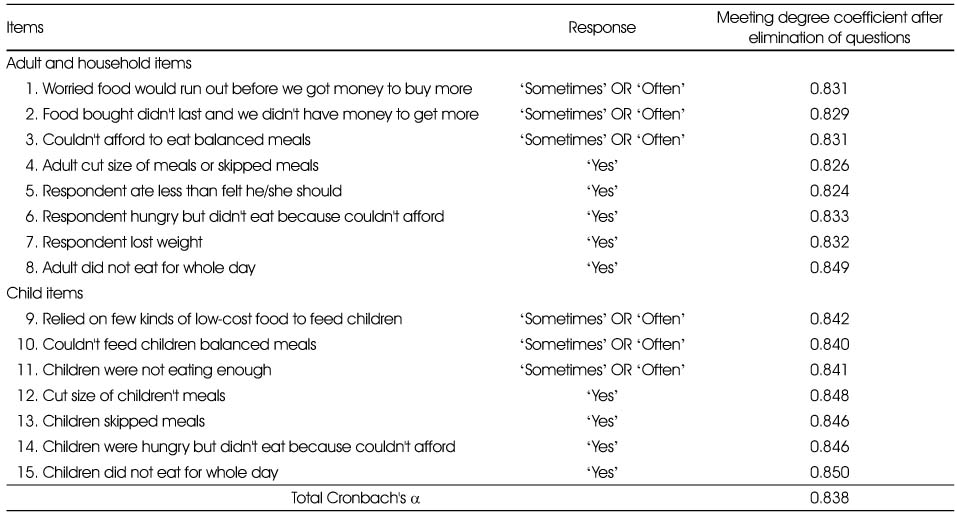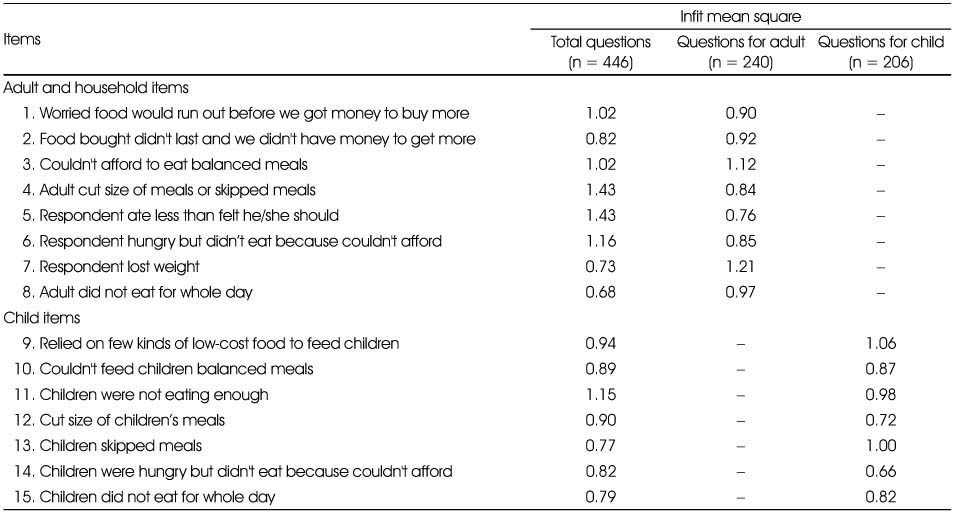References
1. Core indicators of nutritional state for difficult-to-sample populations. J Nutr 1990. 120Suppl 11. 1559–1600.
2. Coates J, Frongillo EA, Rogers BL, Webb P, Wilde PE, Houser R. Commonalities in the experience of household food insecurity across cultures: what are measures missing? J Nutr 2006. 136(5)1438S–1448S.
3. Connell CL, Nord M, Lofton KL, Yadrick K. Food security of older children can be assessed using a standardized survey instrument. J Nutr 2004. 1342566–2572.
4. Food and Agriculture Organization of the United Nations. The State of Food Insecurity in the World 2001 2002a. Rome: Food and Agriculture Organization of the United Nations;
5. Food and Agriculture Organization of the United Nations. Measurement and assessment of food deprivation and undernutrition. International Scientific Symposium 2002b. Rome: Food and Agriculture Organization of the United Nations;
6. Frongillo EA. Validation of measures of food insecurity and hunger. J Nutr 1999. 129506S–509S.
7. Frongillo EA, Nanama S. Development and validation of an experience-based measure of household food insecurity within and across seasons in Northern Burkina Faso. J Nutr 2006. 136(5)1409S–1419S.
8. Gonzalez W, Jimenez A, Madrigal G, Munõoz LM, Frongillo EA. Development and validation of measure of household food insecurity in urban costa rica confirms proposed generic questionnaire. J Nutr 2008. 138587–592.
9. Gulliford MC, Nunes C, Rock EB. The 18 household food security survey items provide valid food security classifications for adults and children in the Caribbean. BMC Public Health 2006. 626.
10. Habicht JP, Pelto G, Frongillo EA, Rose D. Conceptualization and instrumentation of food insecurity. Proceedings of the Workshop on the Measurement of Food Insecurity and Hunger 2004. Washington DC: National Academy Press;
11. Hamilton WL, Cook JT, Thompson WW, Buron LF, Frongillo EA, Olson CM, Wehler CA. Household food security in the United States in 1995. Summary report of the food security measurement project 1997. Washington DC: US Department of Agriculture;
12. Jeong JH, Hwang DS, Kum JH, Lee BH, Park CY. A study on the working poor in Korea. Report no. 2005-03 2005. Seoul: Korea Labor Institute;
13. Kendall A, Olson CM, Frongillo EA. Validation of the Radimer/Cornell measures of hunger and food insecurity. J Nutr 1995. 1252793–2801.
14. Kim K, Hong SA, Kim MK. Nutritional status and food insufficiency of Korean population through the life-course by education level based on 2005 National Health and Nutrition Survey. Korean J Nutr 2008. 41(7)667–681.
15. Kim K, Kim MK. Development and validation of food security measure. Korean J Nutr 2009. 42(4)374–385.
16. Kim K, Kim MK, Shin YJ. Household food insecurity and its characteristics in Korea. Health Soc Welf Rev 2009. 29(2)268–292.
17. Kim K, Kim MK, Shin YJ, Lee SS. Factors related to household food insecurity in the Republic of Korea. Public Health Nutr 2011. 14(6)1080–1087.
18. Korea Health Industry Development Institute. Korean National Health and Nutrition Examination Survey, In depth analysis - Nutrition survey 2003. Seoul: Ministry of Health and Welfare;
19. Korea Health Industry Development Institute. The third(2005) Korean National Health and Nutrition Examination Survey, In depth analysis - Nutrition survey 2007. Seoul: Ministry of Health and Welfare;
20. Korean Nutrition Society. Dietary reference intake for Koreans 2010. Seoul: Hanarum; 23–553.
21. Kwon SO, Oh SY. Associations of household food insecurity with socioeconomic measures, health status and nutrient intake in low income elderly. Korean J Nutr 2007. 40(8)762–768.
22. Lee HJ, Kim MG, Noe DM, Kang SH, Son BD, You JY, Lim WS. The structure of poverty in Korea. Report no. 2006-10 2006. Seoul: Korean Institute for Health and Social Affairs, Ministry of Health and Welfare;
23. Linacre JM. A user's guide to WINSTEPS MINISTEPS: Rasch model computer programs 2004. Chicago: Winsteps.com;
24. Melgar-Quinonez HR, Zubieta AC, MkNelly B, Nteziyaremye A, Gerardo MF, Dunford C. Household food insecurity and food expenditure in Bolivia, Burkina Faso, and the Philippines. J Nutr 2006. 136(5)1431S–1437S.
25. Wunderlich GS, Norwood JL, eds. National Research Council. Food insecurity and hunger in the United States: An assessment of the measure. Panel to Review U.S. Department of Agriculture's Measurement of Food Insecurity and Hunger. Committee on National Statistics, Division of Behaviroal and Social Science and Education 2006. Washington DC: The National Academies Press;
26. Nord M, Andrews M, Carlson S. Household Food Security in the United States in 2005 2006. Washington DC: US Department of Agriculture;
27. Nord M, Andrews M, Carlson S. Household Food Security in the United States in 2007 2008. Washington DC: US Department of Agriculture;
28. Nord M, Bickel G. Measuring children's food security in US household, 1995-99 2002. Washington DC: US Department of Agriculture, Economic Research Service;
30. Oh S-Y, Hong MJ. Food security is associated with dietary intake and body size of Korean children from low-income families in urban area. Eur J Clin Nutr 2003. 57(12)1598–1604.
31. Oh S-Y, Kim K, Kwon SO, Hong SA. Development and validation of Korean food security measures 2010. Seoul: Center for Disease Control & Prevention;
32. Pérez-Escamilla R, Segall-Corra AM, Kurdian Maranha L, Sampaio Md, Marin-Leon L, Panigassi G. An adapted version of the US department of agriculture food insecurity module is a valid tool for assessing household food insecurity in campinas. J Nutr 2004. 1341923–1928.
33. Radimer KL, Olson CM, Campbell CC. Development of indicators to assess hunger. J Nutr 1990. 120Suppl 11. 1544–1548.
34. Shim JS, Oh K, Nam CM. Association of household food security with dietary intake - Based on the third (2005) Korea National Health and Nutrition Examination Survey (KNHANES III). Korean J Nutr 2008. 41(2)174–183.
35. Swindale A, Bilinsky P. Development of a universally applicable household food insecurity measurement tool: Process, current status, and outstanding issues. J Nutr 2006a. 1361449S–1452S.
36. Swindale A, Bilinsky P. Household Dietary Diversity Score (HDDS) for measurement of household food access: Indicator guide 2006b. cited 2010 May 5. Available from
http://www.fantaproject.org/publications.
37. Temple JB. Severe and moderate forms of food insecurity in Australia: are they distinguishable? Aust J Soc Issues 2008. 43649–668.
38. US Department of Agriculture. Guide to measuring household food security 2000. Washington DC: US Department of Agriculture;
39. Webb P, Coates J, Frongillo EA, Rogers BL, Swindale A, Bilinsky P. Measuring household food insecurity: why it's so important and yet so difficult to do. J Nutr 2006. 136(5)1404S–1408S.
40. Wilde PE. Differential response patterns affect food-security prevalence estimates for households with and without children. J Nutr 2004. 1341910–1915.







